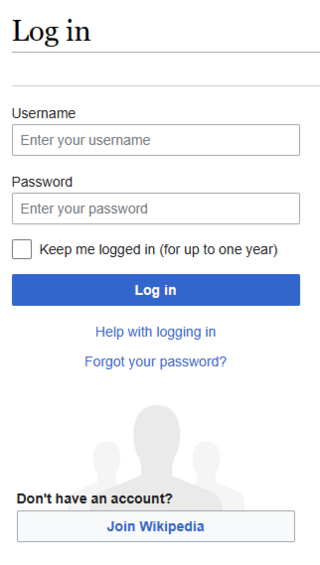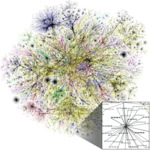Remote Authentication Dial-In User Service (RADIUS) is a networking protocol that provides centralized authentication, authorization, and accounting (AAA) management for users who connect and use a network service. RADIUS was developed by Livingston Enterprises in 1991 as an access server authentication and accounting protocol. It was later brought into IEEE 802 and IETF standards.

An Internet forum, or message board, is an online discussion site where people can hold conversations in the form of posted messages. They differ from chat rooms in that messages are often longer than one line of text, and are at least temporarily archived. Also, depending on the access level of a user or the forum set-up, a posted message might need to be approved by a moderator before it becomes publicly visible.

A captive portal is a web page accessed with a web browser that is displayed to newly connected users of a Wi-Fi or wired network before they are granted broader access to network resources. Captive portals are commonly used to present a landing or log-in page which may require authentication, payment, acceptance of an end-user license agreement, acceptable use policy, survey completion, or other valid credentials that both the host and user agree to adhere by. Captive portals are used for a broad range of mobile and pedestrian broadband services – including cable and commercially provided Wi-Fi and home hotspots. A captive portal can also be used to provide access to enterprise or residential wired networks, such as apartment houses, hotel rooms, and business centers.
Apple Open Collaboration Environment (AOCE) is a collection of messaging-related technologies introduced for the Classic Mac OS in the early 1990s. It includes the PowerTalk mail engine, which is the primary client-side interface to the system, the PowerShare mail server for workgroup installations, and a number of additional technologies such as Open Directory, encryption, and digital signature support.
Single sign-on (SSO) is an authentication scheme that allows a user to log in with a single ID to any of several related, yet independent, software systems.
Java Authentication and Authorization Service, or JAAS, pronounced "Jazz", is the Java implementation of the standard Pluggable Authentication Module (PAM) information security framework. JAAS was introduced as an extension library to the Java Platform, Standard Edition 1.3 and was integrated in version 1.4.
Digital identity refers to the information utilized by computer systems to represent external entities, including a person, organization, application, or device. When used to describe an individual, it encompasses a person's compiled information and plays a crucial role in automating access to computer-based services, verifying identity online, and enabling computers to mediate relationships between entities. Digital identity for individuals is an aspect of a person's social identity and can also be referred to as online identity.

OpenID is an open standard and decentralized authentication protocol promoted by the non-profit OpenID Foundation. It allows users to be authenticated by co-operating sites using a third-party identity provider (IDP) service, eliminating the need for webmasters to provide their own ad hoc login systems, and allowing users to log in to multiple unrelated websites without having to have a separate identity and password for each. Users create accounts by selecting an OpenID identity provider, and then use those accounts to sign on to any website that accepts OpenID authentication. Several large organizations either issue or accept OpenIDs on their websites.
Federated search retrieves information from a variety of sources via a search application built on top of one or more search engines. A user makes a single query request which is distributed to the search engines, databases or other query engines participating in the federation. The federated search then aggregates the results that are received from the search engines for presentation to the user. Federated search can be used to integrate disparate information resources within a single large organization ("enterprise") or for the entire web.
In computer network security, session fixation attacks attempt to exploit the vulnerability of a system that allows one person to fixate another person's session identifier. Most session fixation attacks are web based, and most rely on session identifiers being accepted from URLs or POST data.
Password fatigue is the feeling experienced by many people who are required to remember an excessive number of passwords as part of their daily routine, such as to log in to a computer at work, undo a bicycle lock or conduct banking from an automated teller machine. The concept is also known as password chaos, or more broadly as identity chaos.

In computer security, logging in is the process by which an individual gains access to a computer system by identifying and authenticating themselves. The user credentials are typically some form of username and a matching password, and these credentials themselves are sometimes referred to as alogin. In practice, modern secure systems often require a second factor such as email or SMS confirmation for extra security. Social login allows a user to use existing user credentials from a social networking service to sign in to or create an account on a new website.
A click path or clickstream is the sequence of hyperlinks one or more website visitors follows on a given site, presented in the order viewed. A visitor's click path may start within the website or at a separate third party website, often a search engine results page, and it continues as a sequence of successive webpages visited by the user. Click paths take call data and can match it to ad sources, keywords, and/or referring domains, in order to capture data.
A roaming user profile is a file synchronization concept in the Windows NT family of operating systems that allows users with a computer joined to a Windows domain to log on to any computer on the same domain and access their documents and have a consistent desktop experience, such as applications remembering toolbar positions and preferences, or the desktop appearance staying the same, while keeping all related files stored locally, to not continuously depend on a fast and reliable network connection to a file server.
Privacy-enhancing technologies (PET) are technologies that embody fundamental data protection principles by minimizing personal data use, maximizing data security, and empowering individuals. PETs allow online users to protect the privacy of their personally identifiable information (PII), which is often provided to and handled by services or applications. PETs use techniques to minimize an information system's possession of personal data without losing functionality. Generally speaking, PETs can be categorized as hard and soft privacy technologies.

A user is a person who utilizes a computer or network service.
Multi-factor authentication is an electronic authentication method in which a user is granted access to a website or application only after successfully presenting two or more pieces of evidence to an authentication mechanism. MFA protects personal data—which may include personal identification or financial assets—from being accessed by an unauthorized third party that may have been able to discover, for example, a single password.
A Microsoft account or MSA is a single sign-on personal user account for Microsoft customers to log in to consumer Microsoft services, devices running on one of Microsoft's current operating systems, and Microsoft application software.
Social login is a form of single sign-on using existing information from a social networking service such as Facebook, Twitter or Google, to login to a third party website instead of creating a new login account specifically for that website. It is designed to simplify logins for end users as well as provide more reliable demographic information to web developers.
In computer security, general access control includes identification, authorization, authentication, access approval, and audit. A more narrow definition of access control would cover only access approval, whereby the system makes a decision to grant or reject an access request from an already authenticated subject, based on what the subject is authorized to access. Authentication and access control are often combined into a single operation, so that access is approved based on successful authentication, or based on an anonymous access token. Authentication methods and tokens include passwords, biometric scans, physical keys, electronic keys and devices, hidden paths, social barriers, and monitoring by humans and automated systems.




